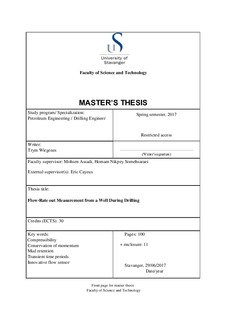| dc.contributor.advisor | Assadi, Mohsen | |
| dc.contributor.advisor | Somehsaraei, Homam Nikpey | |
| dc.contributor.advisor | Cayeux, Eric | |
| dc.contributor.author | Wirgenes, Trym | |
| dc.date.accessioned | 2017-10-26T13:10:23Z | |
| dc.date.available | 2017-10-26T13:10:23Z | |
| dc.date.issued | 2017-06 | |
| dc.identifier.uri | http://hdl.handle.net/11250/2462404 | |
| dc.description | Master's thesis in Petroleum engineering | nb_NO |
| dc.description.abstract | Accurate measurements of flow rate out is crucial in order to prevent unnecessary harm to the environment, equipment or personnel. Harmful situations, such as inflows can potentially be detected earlier with a precise measuring tool. The conventional methods to measuring flow rate out are not flawless, therefore this thesis aims to contribute in the development of a new and innovative measuring method.
This thesis will present technical background and theoretical studies that are relevant to the simulation and experimental part. The simulations investigate the challenges linked with measuring and analyzing flow rate out of a well. The challenges include the effects of fluid compressibility and transient time periods. The experimental part of the thesis describes a new type of flow sensor that is developed and tested.
From the simulation studies, among others the results show that:
• Compressibility effects increases with increasing flow rates
• Effects from compressibility increases with increasing bit depth
• A decreasing effect of compressibility is observed when the density increases
• Compressibility effects increase with increasing OWR
• A trend of increasing compressibility effects is observed for more viscous fluids,
compared to less viscous fluids
• Compressibility effect increases when drilling in open hole sections will lower diameters
The second objective of the thesis was to investigate and verify the measuring principle of a new flow sensor that is developed at IRIS. The experiments were conducted with water as circulation fluid. The results show a trend that correspond with the expected result, but the measuring principle could not be verified, as the measurements were affected by an excessive amount of noise. Regardless, the testing showed various aspects where the new flow sensor could be improved in order to verify the measuring principle. | nb_NO |
| dc.language.iso | eng | nb_NO |
| dc.publisher | University of Stavanger, Norway | nb_NO |
| dc.relation.ispartofseries | Masteroppgave/UIS-TN-IPT/2017; | |
| dc.rights | Attribution-NonCommercial-NoDerivatives 4.0 Internasjonal | * |
| dc.rights.uri | http://creativecommons.org/licenses/by-nc-nd/4.0/deed.no | * |
| dc.subject | petroleumsteknologi | nb_NO |
| dc.subject | petroleum engineering | nb_NO |
| dc.subject | boreteknologi | nb_NO |
| dc.subject | transient time periods | nb_NO |
| dc.subject | innovative flow sensor | nb_NO |
| dc.subject | compressibility | nb_NO |
| dc.subject | mud retention | nb_NO |
| dc.subject | conservation of momentum | nb_NO |
| dc.title | Flow-Rate Out Measurement from a Well During Drilling | nb_NO |
| dc.type | Master thesis | nb_NO |
| dc.subject.nsi | VDP::Technology: 500::Rock and petroleum disciplines: 510::Petroleum engineering: 512 | nb_NO |

